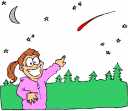
Tips for Observing the 2001 Leonids
By Wes Stone
The Leonid meteor shower produced a spectacular fireball shower in 1998, a storm of several thousand meteors per hour in 1999, and several peaks of up to 400 meteors per hour in 2000. Unfortunately, the Pacific Northwest caught only outlying activity from these events. This year should be better, weather permitting.
Based on predictions by David Asher and Rob McNaught, among others, two major Leonid peaks are predicted in 2001. The most intense will occur for parts of Asia and Australia, but US longitudes may get their own storm on the morning of November 18. This event is probable, but by no means certain. Detailed analyses and predictions can be found in the November issue of Sky and Telescope, as well as at my meteor shower web site: Fall Meteor Showers. Here are five basic rules to keep in mind.
- The main activity is expected before dawn on Sunday morning, November 18. The predictions suggest maximum activity between 2:00am and 2:30am, PST. Such an outburst could last just one or two hours. An ambitious observer would keep watch from about 12:30am through the beginning of morning twilight. Those who are only prepared to watch for a couple of hours may wish to center their observing period around the predicted time of maximum. Don't bother watching in the evening hours. Leonids won't be visible then, because the radiant is still below the horizon. Even after midnight, the rates will probably be low for an hour or so.
- Find clear skies. This could be a daunting prospect, but significant parts of Oregon have been clear during the Leonid peaks in both 1999 and 2000.
- Find dark skies. Your limiting magnitude will dramatically affect the number of meteors you see.
- Dress in warm, comfortable clothes. Clear skies and warm weather generally do not coexist in November.
- Stay informed, and keep your expectations within reason. The major models predict a maximum zenithal hourly rate (ZHR) between 2000 and 2500 for the North American peak. Because the Leonid radiant will only be at around 30° altitude for the Northwest, observed rates under good sky conditions will be only ~50% of the ZHR. While times of outbursts are now fairly predictable, rate forecasts are much less reliable. The actual rate could be much higher or lower than predicted, but this just highlights the need for amateur observations to refine future forecasts. More information is available at the following web sites:
North American Meteor Network
Meteorobs Mailing List
International Meteor Organization

